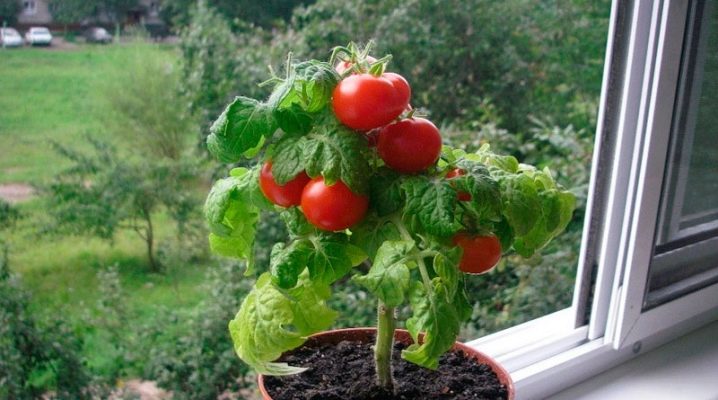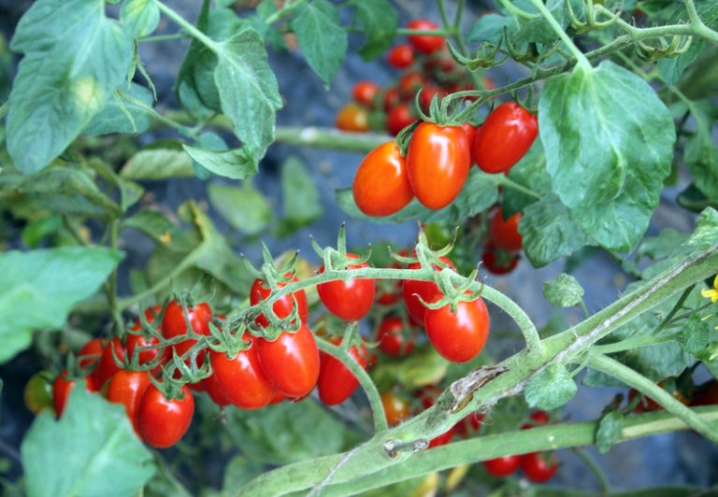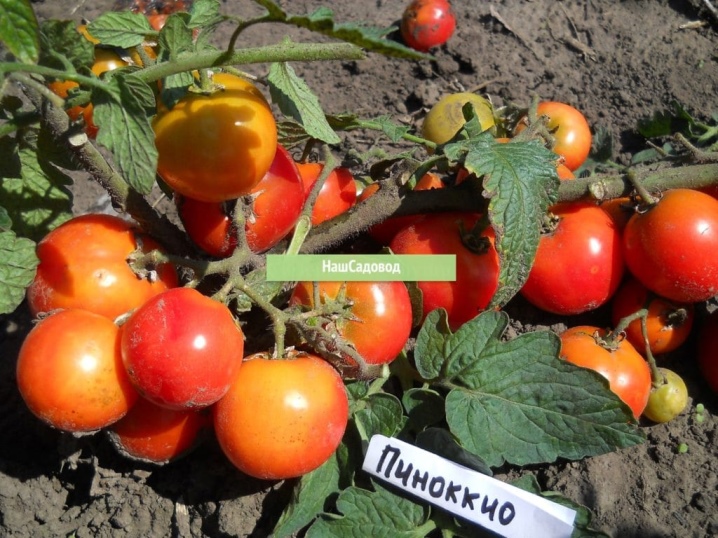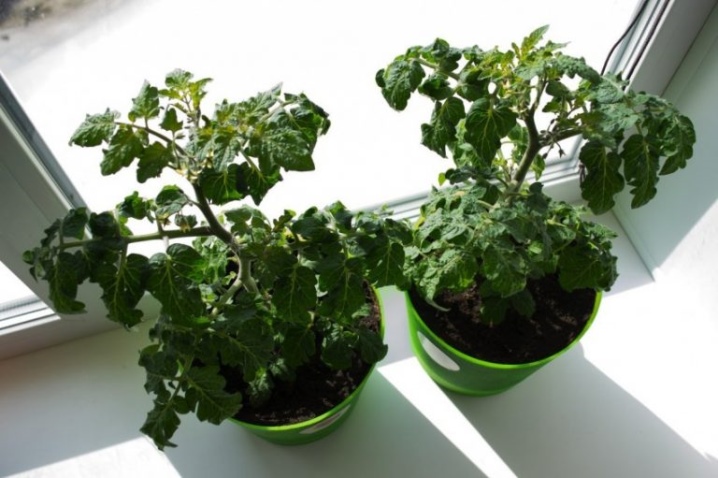Growing tomatoes on a windowsill

A garden or vegetable garden on the balcony is a common thing, especially for city dwellers. The urban jungle theme is relevant and very popular, closely intersecting with the willingness to grow something on the windowsill. For example, tomatoes. And if such an experiment seems to someone like a hopeless gamble, he is very mistaken.


Advantages and disadvantages
Of course, you should not rush headlong into the garden pool - it is not always possible to calculate the strength. Therefore, any practical action is preceded by theoretical training. And it consists in comparing all aspects of the process: pros, cons, possible difficulties, benefits, etc.
The benefits of growing tomatoes on a windowsill are obvious.
- Harvesting all year round is the main plus. The apartment is always warm, which means you don't need to adjust to the seasonality. Getting beautiful tomatoes in a salad in the middle of winter, of course, is a huge temptation for the owners.
- Aesthetics is also very beautiful. Anyone who cannot imagine a house without greenery understands that tomato bushes will decorate the space. And the fruits will be all the more pleasing to the eye.
- In the absence of an alternative, this is better than nothing. It will not work to grow a huge harvest at home, but there will be tomatoes on the table. Moreover, not with the greatest trouble.
- Availability of suitable indoor varieties. Plant growers adapt to the needs of the gardener. This is how varieties appear that are adapted specifically for breeding on the windowsill.

Probably, many are attracted by the very fact of the upcoming process: this is a whole adventure in which a person does not just participate, he controls and directs it. Plants are also interesting because they are alive - they grow, change, go through different phases.
Disadvantages of growing tomatoes on a windowsill.
- The inability to harvest a really big crop. Of course, one cannot compare with a vegetable garden, but the goals are different.
- We'll have to forget about other possible uses of the window sill surface. He will be busy all year round with boxes of tomatoes.
- Sometimes this process is associated with dirty work. Indeed, you cannot hang delicate white curtains where you have to dig in the ground, plant, water, etc. But nobody canceled compromise decisions either.
It is not easy for beginners who do not understand much in crop production. You have to study special sites, look for advice on forums, etc. It happens that you cannot do without keeping a diary: you have to write down every step, observe the growth of seedlings, etc. But tasty and juicy fruits will be the best reward for all efforts.

Suitable varieties
It is worth starting with the fact that only indoor, decorative varieties of tomatoes are grown on the windowsill. These should be bushes up to half a meter high, with short internodes, standard. And even better - varieties up to 30 cm tall. Tomatoes must be resistant to pests and diseases, because saving plants from them in a window sill is very difficult. The variety that the grower chooses must be of the pot type. This means that such a mark must be on the packaging.
By the way, it is definitely not worth ignoring the information indicated on the packaging. The manufacturer almost always indicates the recommended amount of soil mixture, the nuances of care, etc.
Which varieties are suitable for growing on a windowsill?
- Bonsai. A very popular option that offers the cultivation of a squat, branchy bush up to 30 cm high. The fruits grow round, red, weighing up to 25 g. In one season, 1 kg of tomato can be harvested from the bush.

- "Room surprise". And this is a standard variety that grows well on window sills. The bush grows up to half a meter in height, has strong and fairly thick shoots. The fruits are collected in clusters, the weight of one is up to 30 g, oval in shape, red in color. Taste characteristics are excellent.

- Pinocchio. Top variety for growing on a windowsill. Standard, determinant. Tomatoes grow glossy. Up to 1.5 kg of fruit can be harvested from one bush. You can use the crop in salads, and for decorating dishes, and for pickling.

- Minibel. An early type of indoor tomato, which has time to fully ripen in 3 months. The bushes are compact, you can do without pinching when growing. For abundant fruiting, support is required. Tomatoes grow small, but the taste and aroma are very intense.

- "Snegirek". A popular miniature variety, early ripening, pleasing with abundant fruiting. The weight of one fruit is 25 g. It grows perfectly on the windowsill, it pleases with both taste and aroma.

- Florida Petite. The shrub species grows up to 30 cm in height, one fruit can hang 40 g. Sweet, rich in taste, expressively red. On one brush, two dozen fruits can ripen.

- Balcony Red. They are loved for their quick ripening, resistance to diseases and pests, impeccable appearance, juiciness.

These varieties are a versatile choice. They are suitable for ordinary windowsills. But if you plan to grow tomatoes on a wide, and even insulated windowsill, you can pay attention to the following varieties: "Native", "Hermitage", "Igranda", "Baby", "Balconi Yellow".
Landing dates
There are no strict restrictions on this issue, because the landing is not tied to open ground, the expectation of optimal weather conditions, temperature. It all depends on whether the owner intends to get a winter crop of tomatoes or is set up for year-round cultivation. If you want to grow tomatoes for all 4 seasons, seeds are planted in the same number of visits: autumn sowing will be in October and November, February and March will provide a summer harvest.
One way or another, but 3 months for tomatoes to ripen, that is, either engage in "rotational" seating and use more than one window sill, or rely on winter and summer harvests. If in the summer tomatoes are grown as standard on the site, then in October it is worth planting the tomatoes already in the ground on the windowsill - just in time for the winter holidays, homemade fruits will appear.

Location and conditions requirements
Almost all tomatoes are light-loving plants. If you plant them in a dark place, wait for the buds to fall off. Shade resistance has a modest number of varieties. The optimal choice of location is a south-facing window sill.
When cloudy days come, the tomatoes will have to be highlighted with special equipment. These can be energy saving or fluorescent lamps. They will be an adequate substitute for natural ultraviolet light. All three seasons, in addition to summer, can easily be used on the window. Otherwise, everything is standard: competent preparation of seeds and soil, sowing and standard procedures associated with the growth phase of the plant.


How to prepare seeds and soil?
Growing potted tomatoes in a window is not much different from growing garden varieties. In the beginning, the goal is exactly the same - to grow powerful, viable seedlings. This is followed by picking, replanting, etc. But it all starts with seeds. In order to have a guarantee of the quality of seedlings, you need to take it either from "trusted people" (who can reasonably be trusted), or in a specialized store with a good reputation. Store seeds are more likely to match the declared variety.
Hollow seeds must be sorted out after soaking all material in salt water. Those that come up are empty, they are not taken for seedlings. Then the seeds are disinfected, remain for half an hour in a solution of potassium permanganate. And in order for the seeds to sprout as soon as possible, they can be sent to a cloth bag, moistened well and left to swell on a platter for several days.
What is the preparation of the soil:
- the substrate must be chosen nutritious, loose, having neutral acidity (it is better if it is a special soil mixture for tomatoes);
- for winter sowing - definitely a special soil, because its composition is already enriched with nutrients;
- if you are accustomed to preparing the soil yourself, you can use this recipe: 1 part of sand - 2 parts of garden soil; another option suggests taking peat / humus / sod land in an equal ratio; the third option - 1 part of vermiculite - 4 shares of compost and sod land;
- if the soil is taken from a garden or vegetable garden, it is supposed to disinfect it before use (ignite it in the oven or pour boiling water over it).

While everything is going standard, only the scale of planting for home cultivation will be a little more modest.
Sowing
You can use a common container or individual cassettes, peat tablets, cups, etc. If it is decided to take a common container, the container should not be very deep. It is filled with soil mixture, after which it is sufficiently moistened. Seeds are spread at intervals of 1.5-2 cm, and they need to be deepened by a maximum of 2 cm. From above they are sprinkled with a thin layer of earth. You can tamp it a little.
Germination of seeds that have been sown correctly must take place in greenhouse conditions. The growing container can be covered with a lid or foil, and then sent to the windowsill (with good lighting). Periodically, the greenhouse is ventilated, several holes are made in the film so that condensation does not accumulate. At this stage of growth, the temperature conditions for seedlings will be 22-24 degrees during the day, below 20 degrees at night.

Seedling picking
As soon as the first shoots appear, the film must be removed. If glass is used instead of film, it must also be removed. The seedlings are transferred to the windowsill. As soon as 2 true leaves appear on the plant, it's time to dive the tomatoes. Each sprout is dug out with a fork, and the main spine is shortened by exactly one third. The procedure is simple, nevertheless, the plant manages to build up its root volume perfectly after it.

How to transplant?
Usually diving is combined with transplanting seedlings. Each bush is sent to an individual container. It can be a pot, a bucket, a box, whatever - the main thing is proportionality. If you act step by step, then a drainage layer must be laid on the bottom of the container. The substrate is poured there, and the plant is transferred along with the "native" lump.
If the tomatoes are dwarf, a container with a volume of 2 liters will be enough. If the tomatoes are medium-sized, a 4-liter flowerpot will do. If it is decided to grow ampel varieties at home, 5 liter pots are no less suitable for them.
Planting in individual containers is usually not a problem; the plant goes through this procedure quite easily if its rules are not violated. It is important to do this with an understanding of what will happen next.

How to care for tomatoes?
Leaving is a multifactorial process in which a lot of things are mixed. For a novice gardener, some of the words heard about growing tomatoes are new, he is afraid to confuse something, forget about some of the stages. But all this must first be “played” in your head, to allow a successful growing plan to emerge there.
Top dressing
Indoor plants can be fertilized once a week and once every two weeks. Everyone does it in their own way, deriving the rules from their own experience. Mineral complexes are usually well accepted by tomatoes. For example, this: for 1 liter of water, 5 g of superphosphate, 1 g of potassium sulfate, 1 g of urea are taken.
Schedule of dressings for tomatoes on the windowsill:
- the first feeding - when the fifth or sixth true leaves are formed;
- the second top dressing - at the very beginning of flowering;
- the third feeding - during the formation of the first ovaries.
If at home you want to use only organic matter, there are options for it: mullein solution - 1 share of dry mass is taken per 5 parts of water, or a solution of bird droppings - 1 share of dry mass to 15 parts of water. True, it is worth warning beginners, the smell of organic feeding is very dubious for the conditions of the house.

Feeding, of course, is not enough. Tomatoes need to be watered with discipline. This culture does not like hypothermia, as soon as it is watered with cold water and / or arranges drafts, expect trouble. Therefore, it is better to defend water for irrigation in the sun; artificial lighting can also be used. Plants can only be watered with warm water, not lower than 20 degrees.
The nuances of watering home tomatoes:
- water a lot - the roots will rot;
- the best marker of the need for watering is the drying of the substrate;
- water must be poured onto the ground, and not onto the root base;
- it is better to protect the leaves from water, otherwise it can result in a burn for the plant.
Humid air is another essential care element for home tomatoes. If the batteries are heated in the house, tomatoes do not really like this. Therefore, you regularly need to ventilate the room, place containers with water next to the boxes / pots with tomatoes. But this is if the room is stuffy. But in winter, the bushes can be sprayed with warm water from a spray bottle (remembering that this cannot be done in direct sunlight), or even better, turn on a humidifier.
After watering, the plant may need loosening. This is useful for breaking up the earth crust and more.

Tying and shaping
There are several more procedures without which tomatoes cannot be grown. What else can you need in caring for homemade tomatoes?
- Pollination. Usually indoor varieties of tomatoes are self-pollinated. But you can even help such varieties: slightly shake the flower pots in which the bushes are located, carry a feather over the flowers to carry pollen. This does not mean pollinating yourself, this is just additional, unnecessary manipulations.
- Fruit formation, stimulation. As soon as the process of setting fruit on a bush became visible, you can do this - take 1 g of boric acid, dilute it in 1 liter of water. And spray the working brushes with this liquid.
- Tying. Not all tomatoes need such a procedure, only those varieties where large tomatoes ripen. You need to put pegs in the container and tie the bushes to them using a regular bandage or rope made of natural materials.
- Hilling. With an ordinary fork, you can pick up the soil to the base of the bush. This is effective for creating new roots.
And adult plants need to be poured with soil mixture. Yet the bush develops, which depletes the substrate.


Diseases and pests
One of the biggest misfortunes that homemade tomatoes face is late blight. Even if everything is done correctly, the soil is disinfected, the seeds are selected, the disease can come. Therefore, the prevention of late blight will definitely not be an unnecessary measure. It is necessary to prepare 1 crystal of potassium permanganate for 3 liters of water, half a chopped garlic head. This mass is infused for about a day, filtered. And with this composition you need to spray the bushes.
What diseases does this mean?
- Leaves curl during the day, possibly dry. This means that the plant is hot, stuffy. It needs to be shaded (with a newspaper), turn on a humidifier.
- The foliage goes up at an acute angle. The plant lacks moisture, light, or the air is simply dry. It is necessary to revise the irrigation schedule, adjust the air humidity indicators, not forgetting about artificial lighting.
- The plant does not bloom, but only gains green mass. So the tomatoes are overfed with nitrogen.You need to stop watering them for at least a week, spray them with superphosphate, and then manually (using a brush) pollinate the flowers.
It is obvious that growing tomatoes on a windowsill is working with rules, schemes, recommendations. But still, you have to take care not of a whole garden, but of several bushes.












The comment was sent successfully.